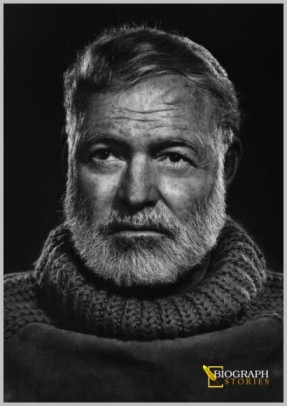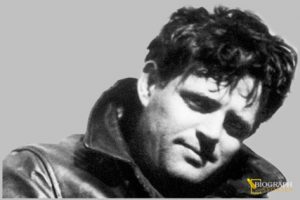
Ernest Miller Hemingway Quick Fact:
Born: July 21, 1899 in Oak Park, Illinois
Died: July 2, 1961 in Ketchum, Idaho
Education: Oak Park High School
Spouse(s): Hadley Richardson (m. 1921–1927), Pauline Pfeiffer (1927–1939), Martha Gellhorn (1940–1945), Mary Welsh (1946–1961)
Biography of Ernest Miller Hemingway:
An American journalist, novelist, short-story writer, and sportsman, Ernest Miller Hemingway, one of the most celebrated and influential author of the twentieth century and served in World War I and worked in journalism before publishing his story collection In Our Time. He was awarded with Nobel Prize for Literature in 1954. Ernest’s writing style became an inspiration for many crime and pulp fiction novels. Many books of his are considered as classics of American literature. He was renowned for novels like The Sun Also Rises, A Farewell to Arms, For Whom the Bell Tolls, and The Old Man and the Sea, which won the 1953 Pulitzer.
Early Life of Ernest Miller Hemingway:
On the 21st of July 1899 in Oak Park, Chicago, Ernest Miller Hemingway was born. Ernest was born to a simple family. His father was a country physician and his mother was a religious woman, active in church affairs. Clarence and Grace Hemingway raised their son in this conservative suburb of Chicago, but the family also spent a great deal of time in northern Michigan, where they had a cabin. He was educated in the public schools and was very popular in high school because he proved himself as a scholar and athlete. He used to spend the summers with his family in the woods of northern Michigan and it was best part of his boyhood.
In high school, Hemingway worked on his school newspaper, Trapeze and Tabula, writing primarily about sports. Immediately after graduation, the budding journalist went to work for the Kansas City Star, gaining experience that would later influence his distinctively stripped-down prose style.
Military Experience
Hemingway went overseas as an ambulance driver to serve in World War I in 1918. For his excellent service and reputation, he was awarded the Italian Silver Medal of Bravery. But the glory did not work for long time and he landed in a hospital in Milan due to severe war injury.
He met his first love, a nurse named Agnes von Kurowsky, during his treatment but unfortunately he was left behind by her for another man. This devastated the young writer but encouraged him to make his first writing attempt “A Very Short Story” also known as, ‘A Farewell to Arms’.
Still nursing his injury and recovering from the brutalities of war at the young age of 20, he returned to the United States and spent time in northern Michigan before taking a job at the Toronto Star.
In Chicago, Hemingway met Hadley Richardson, the woman who would become his first wife. The couple married and quickly moved to Paris and there Hemingway worked as a foreign correspondent for the Star.
Life in Europe:
In Paris, Hemingway soon became a key part of “The Lost Generation.” With Stein as his mentor, Hemingway made the acquaintance of many of the great writers and artists of his generation, such as F. Scott Fitzgerald, Ezra Pound, Pablo Picasso and James Joyce. In 1923, his first son John Hadley Nicanor Hemingway was born. By this time the writer had also begun frequenting the famous Festival of San Fermin in Pamplona, Spain.
In 1925, the couple, took a trip to the festival that would later provide the basis of Hemingway’s first novel, The Sun Also Rises and joined a group of British and American expatriates. The novel is widely considered Hemingway’s greatest work, artfully examining the postwar disillusionment of his generation.
After the publication of The Sun Also Rises, Hemingway and Hadley divorced, due in part to his affair with a woman named Pauline Pfeiffer, who would become Hemingway’s second wife shortly after his divorce from Hadley was finalized. The author continued to work on his book of short stories, Men without Women.
Later life and Death:
Soon after his second marriage, Pauline became pregnant and they decided to move back to America. After the birth of their son Patrick Hemingway in 1928, they settled in Key West, Florida. During this time, Hemingway finished his celebrated World War I novel A Farewell to Arms, securing his lasting place in the literary canon.
In his later life when he wasn’t writing, Hemingway spent much of the 1930s chasing adventure like big-game hunting in Africa, bullfighting in Spain, deep-sea fishing in Florida. While reporting on the Spanish Civil War in 1937, Hemingway met a fellow war correspondent named Martha Gellhorn (soon to become wife number three) and gathered material for his next novel, For Whom the Bell Tolls. His this work later on was nominated for the Pulitzer Prize.
His marriage to Pauline Pfeiffer failed and the couple divorced. Gellhorn and Hemingway married soon after and purchased a farm near Havana, Cuba.
When the United States entered World War II in 1941, Hemingway served as a correspondent and was present at several of the war’s key moments, including the D-Day landing. Toward the end of the war, Hemingway met another war correspondent, Mary Welsh, whom he would later marry after divorcing Martha Gellhorn.
In 1951, Hemingway wrote The Old Man and the Sea, which would become perhaps his most famous book, finally winning him the Pulitzer Prize he had long been denied.
In 1954, he won the Nobel Prize in Literature. Even at this peak of his literary career, though, the burly Hemingway’s body and mind were beginning to betray him. Recovering from various old injuries in Cuba, Hemingway suffered from depression and was treated for numerous conditions such as high blood pressure and liver disease.
He wrote A Moveable Feast, a memoir of his years in Paris, and retired permanently to Idaho. Early on the morning of July 2, 1961, Ernest Hemingway committed suicide in his Ketchum home.
Hemingway left behind an impressive body of work and an iconic style that still influences writers today. His personality and constant pursuit of adventure loomed almost as large as his creative talent.
Notable Works:
- The Sun Also Rises,
- A Farewell to Arms,
- Death in the Afternoon,
- For Whom the Bell Tolls,
- The Old Man and the Sea,
- A Moveable Feast








